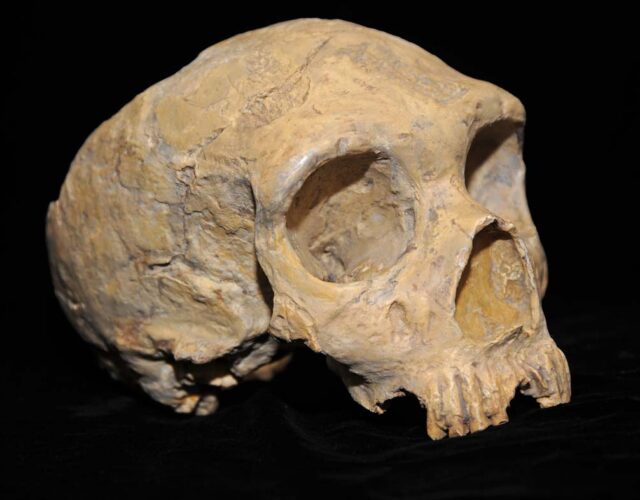Studying ancient DNA (aDNA) is a lot like playing Whac-A-Mole: stamp out one problem and another will pop up and take its place. Contamination, corruption, chromosomal shredding—it’s a miracle scientists can even find aDNA in specimens, much less glean information from it. But a few recent breakthroughs have greatly expanded our ability to read aDNA and have already opened whole new vistas of human evolution.
DNA disappears after cells die for a few reasons. All healthy cells have enzymes that shred DNA to recycle it, and unfortunately those enzymes keep right on shredding after death. Water and oxygen in the environment also react with DNA’s backbone and degrade it further. I’d say these processes reduce DNA to confetti, but that doesn’t do justice to just how thorough the destruction is. It’s more like confetti making its own even tinier confetti, which in turn makes its own confetti. After a few thousand years a multibillion-base-pair genome might be reduced to scraps a few dozen letters long—a 100 million−fold reduction.
Cold, dry environments can lessen the chance for damage, however, both by preventing water from attacking DNA and by dismantling the DNA-shredding enzymes. That’s why the best aDNA comes from samples unearthed in tundras or caves. Recent advances in computing power have also allowed scientists to assemble sequences from even minute scraps of DNA. The oldest recovered genome so far came from a horse’s leg bone buried in Canada’s Yukon Territory for 700,000 years; with the right sample and ever-better software to analyze it, scientists think they can push that back to one million years.
Finding the right sample solves only one problem, though. In most ancient tissues 99% of the DNA present comes from contamination by invading fungi and bacteria. So scientists have to deploy chemical snares, like “RNA bait.” If searching for human DNA, researchers would prepare the bait by manufacturing millions of strips of human RNA (DNA’s chemical cousin), albeit with one modification: these RNA strips have chemical Velcro attached to one end. When mixed into a sample, this RNA gloms onto the human DNA and only the human DNA. Scientists then pour in tiny metallic beads that—here’s the key—also have chemical Velcro attached, locking the beads and the RNA/DNA strips together. Finally, a magnet holds onto the beads as the un-Velcroed microbial DNA washes away, leaving behind pristine samples. While this technique is expensive—developing the RNA bait can cost $300,000—new methods promise to drop that price to roughly $50.
Just when geneticists have isolated the human DNA, however, an even more insidious problem arises: corruption, also called deamination. Deamination occurs when water or oxygen snips off an NH2 group (an amine) from the DNA base cytosine (C); cells then patch in a double-bonded oxygen atom instead. This patch changes C to a different genetic “letter.” This letter (uracil, U) normally doesn’t appear in DNA; but the enzymes that copy DNA read it anyway (as thymine, T). As a result the text gets garbled, with too few Cs and too many Ts. It’s like rescuing a Gutenberg Bible from a fire, then finding that random words have been changed.
Geneticists haven’t quite cracked this problem yet. They can now filter out aDNA with uracil so at least they’re not misled by corruption. The problem is, many samples have so little usable aDNA that scientists can’t afford to throw any away. Still, new techniques continue to bring more and more of this marginal aDNA “inbounds” and allow us to sequence it.
In addition to the technical thrill of teasing out small traces of DNA, paleogenetics is important because it can illuminate vital aspects of human evolution. DNA extracted from bones found in cold European caves has already demonstrated that anatomically modern human beings interbred with Neanderthals long ago, something few scientists had considered likely. We’ve also discovered that Neanderthals shared some of the genes that help us speak—raising the startling possibility that Neanderthals were articulate.
Neanderthals represent only one lineage of hominid evolution, however. Ancient DNA from other hominids, such as Homo floresiensis, the 13,000-year-old “hobbit” discovered in 2003, has proved more elusive: every attempt to extract genetic material has failed so far. That’s because the hobbit’s homeland, hot and humid Indonesia, is pretty much custom-designed to degrade DNA. The DNA from still older specimens in Africa, the cradle of humanity, will likely be even harder to extract.
But the smart money says that we will extract it someday. Paleogenetics is barely 30 years old, and the Neanderthal aDNA work really got going only in 2006; so the prospects for improvement are vast. To be sure, there are thermodynamic limits to biological materials: the chances of us stumbling across intact dinosaur DNA are nil. But most of humankind’s important evolutionary leaps took place within the thermodynamic life span of aDNA; and although it has been hiding out for hundreds of thousands of years, it can’t hide from our chemical snares forever.




